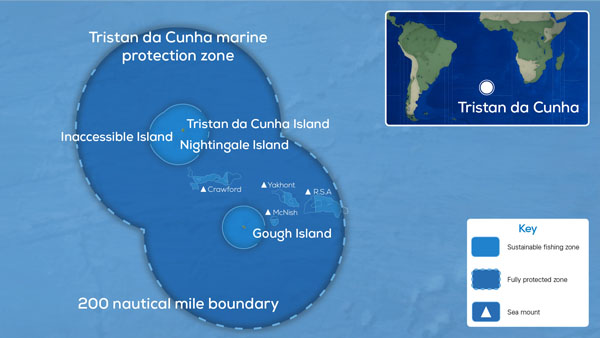BOT Island Focusing On Marine Protection
Tristan da Cunha – an island British Overseas Territory [BOT] like Bermuda – has become “one of the world’s biggest sanctuaries for life above and below the waves thanks to an international partnership that is supporting the local community and protecting nature” as “almost 700,000 square kilometers of its waters will join the UK’s Blue Belt of marine protection.”
The Tristan da Cunha government news website said, “On Friday 13th November 2020, the most remote inhabited island on Earth becomes one of the world’s biggest sanctuaries for life above and below the waves thanks to an international partnership that is supporting the local community and protecting nature.
Antje Steinfurth’s photo shows Tristan da Cunha from Nightingale Island:
“The community of Tristan da Cunha, a small chain of islands over 6,000 miles from London in the South Atlantic has declared that almost 700,000 square kilometers of its waters will join the UK’s Blue Belt of marine protection, becoming the largest no-take zone in the Atlantic and the fourth largest on the planet.
“The 687,247 square kilometer Marine Protection Zone – almost three times the size of the UK – will safeguard one of the world’s most pristine marine environments and protect the wealth of wildlife that lives there.
“The Marine Protection Zone around Tristan is the gold standard of marine protection, with no fishing or other extractive activities permitted across the whole area, also known as a ‘no-take zone’. This move makes the Tristan islanders the guardians of the largest no-take zone in the relatively unprotected Atlantic Ocean.
Sue Scott’s photo shows a typical Tristan da Cunha seabed showing a klipfish which is endemic to the islands:
“A recent study by the University of California and the National Geographic Society [see notes] found that banning fishing in 5 per cent or more of the ocean would boost global fish catches by at least 20 per cent in future.
“The announcement, made by the Tristan da Cunha Government, helps the UK Government with its ambition to lead the global effort to tackle the nature crisis and secure protection of 30% of the world’s oceans by 2030.The UK has a duty to protect the wildlife found in all of its Territories and will be responsible for long-term monitoring and enforcement of this vast Zone.
The Tristan da Cunha Marine Protection Zone:
“Tristan da Cunha has a long history of protecting its unique environment. This latest success is the result of 20 years of hard work.
“It began with the RSPB working with the Government of Tristan da Cunha to lay the conservation ground work and support Tristan’s exemplary management of its sustainable lobster fishery, then the five-year programme of UK Government Blue Belt support, followed by an international coalition of partners who have generously supported the final phase.
Paul Tyler’s photo shows a Tristan Rock Lobster, Jasus Tristani, Crayfish or Crawfish:
“The RSPB along with National Geographic also partnered with the Blue Nature Alliance, Becht Family Charitable Trust together with Blue Marine Foundation, Wyss Foundation, Kaltroco and Don Quixote II Foundation to enable this large-scale declaration.
“Tristan da Cunha is an archipelago located 2,400km from the nearest land.”
Read More About
Category: All, Environment






